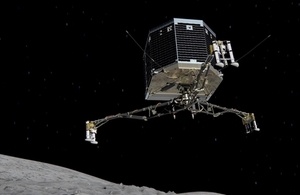Rosetta to deploy lander on 12 November
Europe’s Rosetta mission will deploy its lander, Philae, to the surface of Comet 67P/Churyumov–Gerasimenko on 12 November.

Artist's impression of Philae descending to the surface of comet 67P/CG. Credit: ESA/ATG medialab.
Philae’s landing site, currently known as Site J, is located on the smaller of the comet’s two ‘lobes’, with a backup site on the larger lobe. The sites were selected just six weeks after Rosetta arrived at the comet on 6 August, following its 10-year journey through the Solar System.
In that time, the Rosetta mission has been conducting an unprecedented scientific analysis of the comet, a remnant of the Solar System’s 4.6 billion-year history. The latest results from Rosetta will be presented on the occasion of the landing, during dedicated press briefings.
The main focus to date has been to survey 67P/Churyumov–Gerasimenko in order to prepare for the first ever attempt to soft-land on a comet.
Site J was chosen unanimously over four other candidate sites as the primary landing site because the majority of terrain within a square kilometre area has slopes of less than 30º relative to the local vertical and because there are relatively few large boulders. The area also receives sufficient daily illumination to recharge Philae and continue surface science operations beyond the initial 64-hour battery-powered phase.
Over the last two weeks, the flight dynamics and operations teams at ESA have been making a detailed analysis of flight trajectories and timings for Rosetta to deliver the lander at the earliest possible opportunity.
Two robust landing scenarios have been identified, one for the primary site and one for the backup. Both anticipate separation and landing on 12 November.
For the primary landing scenario, targeting Site J, Rosetta will release Philae at 08:35 GMT/09:35 CET at a distance of 22.5 km from the centre of the comet, landing about seven hours later. The one-way signal travel time between Rosetta and Earth on 12 November is 28 minutes 20 seconds, meaning that confirmation of the landing will arrive at Earth ground stations at around 16:00 GMT/17:00 CET.
If a decision is made to use the backup Site C, separation will occur at 13:04 GMT/14:04 CET, 12.5 km from the centre of the comet. Landing will occur about four hours later, with confirmation on Earth at around 17:30 GMT/18:30 CET. The timings are subject to uncertainties of several minutes.

Philae on the comet. Credit: ESA/ATG medialab.
Final confirmation of the primary landing site and its landing scenario will be made on 14 October after a formal Lander Operations Readiness Review, which will include the results of additional high-resolution analysis of the landing sites conducted in the meantime. Should the backup site be chosen at this stage, landing can still occur on 12 November.
A competition for the public to name the primary landing site will also be announced during the week of 14 October.
The Rosetta orbiter will continue to study the comet and its environment using its 11 science instruments as they orbit the Sun together. The comet is on an elliptical 6.5-year orbit that takes it from beyond Jupiter at its furthest point, to between the orbits of Mars and Earth at its closest to the Sun. Rosetta will accompany the comet for more than a year as they swing around the Sun and back to the outer Solar System again.
The analyses made by the Rosetta orbiter will be complemented by the in situ measurements performed by Philae’s 10 instruments.
An invitation to media with an outline of the programme for the 12 November event will be issued soon.
Rosetta and the UK
With funding from the UK Space Agency, Rosetta is a mission with significant UK involvement. UK scientists are involved in ten of the 21 experiments that Rosetta will carry out during its mission:
- the Open University is leading the team for the Ptolemy instrument on the lander
- Armagh Observatory will be helping to analyse the results from the OSIRIS instrument
- Imperial College London and University College London’s Mullard Space Science Laboratory (MSSL) supply the team studying the comet’s plasma
- scientists at Oxford University are part of the science team for VIRTIS
- Queen Mary College at the University of London will be investigating the results of the CONSERT instrument
Industry involvement
The following UK companies have been involved in the mission:
- Airbus Defence and Space, based in Stevenage, was the major subcontractor for the Rosetta platform
- the Science & Technology Facilities Council (STFC) Rutherford Appleton Laboratory managed to reduce a lab full of chemistry equipment to enable it to fit into a space the size of a shoebox
- SciSys UK Ltd is responsible for the spacecraft Mission Control System development and maintenance; in recognition of this work on the Rosetta and the Beagle 2 missions, SciSys were awarded the title of “Innovator of the Year” by the UK Computing Awards for Excellence 2004
- VEGA Group plc was involved in many aspects of the Rosetta mission, from the overall design of the spacecraft to the on board software technology created by Logica (now CGI) helped to explore some of the issues involved in such a long mission, the company was also involved in the development of the Rosetta on board software
- AEA Battery Systems Limited provided innovative batteries for the spacecraft and lander. These are smaller, lighter and much more reliable than the traditional nickel-cadmium batteries
- AEA Technology, European Space Tribology Laboratory (ESTL) developed the Micro-Imaging Dust Analysis System (MIDAS)
- Polyflex Space Ltd provided tanks to store the helium used by the lander
- Surrey Satellite Technology Limited (SSTL) designed a wheel that will stabilise the probe as it descends and lands on the comet